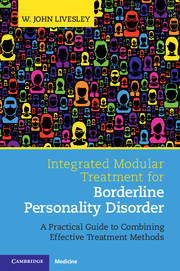 Integrated Modular Treatment for Borderline Personality Disorder
Integrated Modular Treatment for Borderline Personality Disorder Book contents
- Frontmatter
- Dedication
- Contents
- Preface
- Section 1 Introduction and Framework for Understanding Borderline Personality Disorder
- 1 Introduction
- 2 Understanding Normal and Disordered Personality
- 3 Understanding Borderline Personality Disorder
- 4 Origins and Development
- Section 2 Assessment and Treatment Planning
- Section 3 General Treatment Modules
- Section 4 Safety, Containment, and Engagement: The Initial Phase of Treatment
- Section 5 Improving Emotional Regulation and Modulation
- Section 6 Exploration and Change: Treating Interpersonal Problems
- Section 7 Constructing an Adaptive Sense of Self
- Section 8 Retrospect and Prospect
- References
- Index
1 - Introduction
from Section 1 - Introduction and Framework for Understanding Borderline Personality Disorder
Published online by Cambridge University Press: 16 February 2017
- Frontmatter
- Dedication
- Contents
- Preface
- Section 1 Introduction and Framework for Understanding Borderline Personality Disorder
- 1 Introduction
- 2 Understanding Normal and Disordered Personality
- 3 Understanding Borderline Personality Disorder
- 4 Origins and Development
- Section 2 Assessment and Treatment Planning
- Section 3 General Treatment Modules
- Section 4 Safety, Containment, and Engagement: The Initial Phase of Treatment
- Section 5 Improving Emotional Regulation and Modulation
- Section 6 Exploration and Change: Treating Interpersonal Problems
- Section 7 Constructing an Adaptive Sense of Self
- Section 8 Retrospect and Prospect
- References
- Index
Summary
This book describes a different way to treat borderline personality disorder (BPD). Rather than using one of the manualized treatments developed in recent years, a trans-theoretical approach is proposed that combines principles, strategies, and interventions from all effective treatments. Reluctantly, I decided that a name was needed for this approach and decided on integrated modular treatment (IMT). However, my intention is not to develop yet another therapy described by a three-letter acronym but rather to show how therapists can make use of effective methods from all therapies without adopting either the total treatment package or the underlying theory.
This is not how BPD is currently treated. Treatment is usually based on one or more of the following specialized treatments shown to be effective in randomized controlled trials: dialectical behaviour therapy (DBT), transference-focused therapy (TFT), schema-focused therapy (SFT), mentalizing-based therapy (MBT), cognitive-behavioural therapy (CBT), cognitive-analytic therapy (CAT), and systems training for emotional predictability and problem-solving (STEPPS). Since these treatments do not differ in effectiveness, however, there are no scientific grounds for selecting one approach over another. Nor do they produce better outcomes than good clinical care or supportive therapy. Hence, it may be more effective to combine the effective ingredients of all therapies rather than choose among them.
There are other reasons to pursue integration. Current treatments are not comprehensive: most are based on theories that explain BPD largely in terms of a single impairment, which then becomes the main focus of therapy with other impairments receiving less attention. Thus, DBT considers emotional dysregulation to be the primary problem. MBT assumes that it is impaired mentalizing (difficulty understanding the mental states of self and others). SFT focuses primarily on early maladaptive schemas – beliefs that originated in dysfunctional relationships with significant others during early development. Finally, TFT assumes that problems are largely due to disturbances in the structure of personality. Each explanation has merit: BPD does indeed involve emotional dysregulation, dysfunctional cognitions, impaired mentalizing, and structural problems with personality, but patients do not have just one of these impairments, they have all of them. Hence, a trans-theoretical approach makes more sense.
- Type
- Chapter
- Information
- Integrated Modular Treatment for Borderline Personality DisorderA Practical Guide to Combining Effective Treatment Methods, pp. 1 - 13Publisher: Cambridge University PressPrint publication year: 2017


